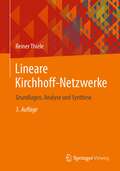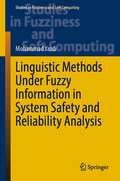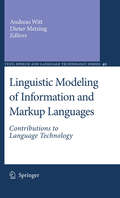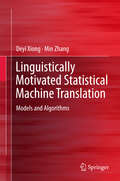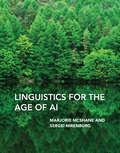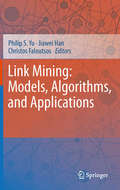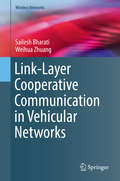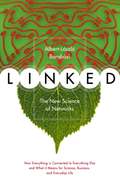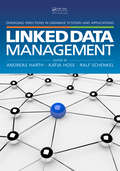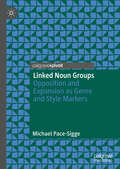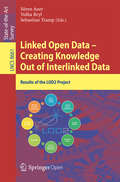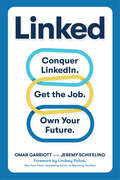- Table View
- List View
Lineare Kirchhoff-Netzwerke: Grundlagen, Analyse und Synthese
by Reiner ThieleDas Buch vermittelt ausgehend von den Grundlagen der Netzwerk-Theorie neuartige Analyse- und Syntheseverfahren für lineare zeitinvariante Kirchhoff-Netzwerke. Hierzu verwendet der Autor als Elementarnetzwerke gewöhnliche Widerstände, Kondensatoren und Spulen sowie die sogenannten pathologischen Unternetzwerke Nullator, Norator und Nullor. Der Nullor besteht dabei aus einem Nullator und einem Norator, wird hinsichtlich seines Klemmenverhaltens durch die Belevitch-Darstellung beschrieben und näherungsweise durch einen Operationsverstärker realisiert. Zur Analyse oder Synthese erfolgt die Zerlegung in realisierbare Unternetzwerke mit dem Verfahren der Singulärwert-Zerlegung von Matrizen. Außerdem zeigt Reiner Thiele, wie durch die Applikation von Klemmen-Äquivalenzen praxisrelevante elektrische oder elektronische Schaltungen entstehen.
Lineare Kirchhoff-Netzwerke: Grundlagen, Analyse und Synthese
by Reiner ThieleDas Buch vermittelt ausgehend von den Grundlagen der Netzwerk-Theorie neuartige Analyse- und Syntheseverfahren für lineare zeitinvariante Kirchhoff-Netzwerke. Hierzu verwendet der Autor als Elementarnetzwerke gewöhnliche Widerstände, Kondensatoren und Spulen sowie die sogenannten pathologischen Unternetzwerke Nullator, Norator und Nullor. Der Nullor besteht dabei aus einem Nullator und einem Norator, wird hinsichtlich seines Klemmenverhaltens durch die Belevitch-Darstellung beschrieben und näherungsweise durch einen Operationsverstärker realisiert. Zur Analyse oder Synthese erfolgt die Zerlegung in realisierbare Unternetzwerke mit dem Verfahren der Singulärwert-Zerlegung von Matrizen. Außerdem zeigt Reiner Thiele, wie durch die Applikation von Klemmen-Äquivalenzen praxisrelevante elektrische oder elektronische Schaltungen entstehen.
Lingo in a Nutshell
by Bruce A. EpsteinMacromedia Director 6 is the premiere authoring tool for delivering interactive content on both the Internet and the desktop. It is the dominant multimedia package for Windows 95/NT, Windows 3.1, and the Macintosh. A quarter million developers use Director(R) to incorporate animation and audio into dynamic Web pages, and to create engaging interactive corporate presentations, multimedia advertising, entertainment CD-ROMs, Enhanced music CDs, and even DVDs. Lingo is Director's powerful scripting language. This companion book to Director in a Nutshell is an essential tool for both new and experienced Lingo programmers seeking a deeper knowledge of the language. Bruce Epstein is the author of both these books and brings years of hands-on experience with Director and Lingo. The book includes numerous useful Lingo examples. Exhaustively tested, this book corrects many errors found in Macromedia's Lingo documentation and repeated verbatim in most third-party books. Extremely comprehensive, this book details dozens of misdocumented and undocumented Lingo keywords that are omitted from Macromedia's manuals and third-party books. Lingo in a Nutshell caters to the huge pool of Director users attempting to bridge the Lingo gap, yet provides the details for the experienced Linguist that are lacking in other Lingo books. In typical nutshell style (clear, concise, deep and narrow) this book explores the syntax, structure and commands of the Lingo language. The detailed chapters describe messages, events, scripts, handlers, variables, lists, file I/O, Behaviors, child objects, Xtras, and more. This book teaches you to troubleshoot and debug common Lingo errors. Lingo in a Nutshell is the book for which both Director users and power Lingo programmers have been yearning. The book extensively covers topics not found in other Lingo books: Cross-platform Lingo differences Lingo internals for experienced programmers Events, messages, and scripts Timers, tempos, cue points, and synchronization Data types and expressions Math, numerical expressions, geometry, and trigonometry Coordinates, alignment, and registration point Lingo in a Nutshell is the most concise and compete guide available. It is a high-end handbook at a low-end price. An essential desktop reference for every Director user.
Linguistic Linked Open Data
by Diana Trandabăţ Daniela GîfuThis book constitutes therefereed proceedings of the 12th EUROLAN Summer School on Linguistic Linked Open Data and its Satellite Workshop on Social Media and the Web of Linked Data, RUMOUR 2015, held in Sibiu, Romania, in July 2015. The 10 revised full papers presented together with 12 abstracts of tutorials werecarefully reviewed and selected from 21 submissions.
Linguistic Methods Under Fuzzy Information in System Safety and Reliability Analysis (Studies in Fuzziness and Soft Computing #414)
by Mohammad YazdiThis book reviews and presents a number of approaches to Fuzzy-based system safety and reliability assessment. For each proposed approach, it provides case studies demonstrating their applicability, which will enable readers to implement them into their own risk analysis process.The book begins by giving a review of using linguistic terms in system safety and reliability analysis methods and their extension by fuzzy sets. It then progresses in a logical fashion, dedicating a chapter to each approach, including the 2-tuple fuzzy-based linguistic term set approach, fuzzy bow-tie analysis, optimizing the allocation of risk control measures using fuzzy MCDM approach, fuzzy sets theory and human reliability, and emergency decision making fuzzy-expert aided disaster management system.This book will be of interest to professionals and researchers working in the field of system safety and reliability, as well as postgraduate and undergraduate students studying applications of fuzzy systems.
Linguistic Modeling of Information and Markup Languages
by Andreas Witt Dieter MetzingThis book addresses the interests of a large community of researchers in the fields of XML-based annotation techniques and corpus-based language technology. It covers the most significant recent developments in this field, from multi-layered mark-up and standards to theoretical formalisms to applications. The contributions are based on research projects at international level in text technology, computational linguistics, hypertext modeling and in the domain of standards and tools for language resources. Core topics are: strategies for multi-layered document modeling and processing, mark-up at different levels for textual resources, and text-technological information modeling. The sections of the book offer an exhaustive coverage of many of the current topics in the fields concerned, especially: Multi-layered Markup; Markup Languages and Language Resources; Markup and Text Types; Markup Languages and Hypertext; Markup and Formalization.
Linguistic Resources for Natural Language Processing: On the Necessity of Using Linguistic Methods to Develop NLP Software
by Max SilberzteinEmpirical — data-driven, neural network-based, probabilistic, and statistical — methods seem to be the modern trend. Recently, OpenAI’s ChatGPT, Google’s Bard and Microsoft’s Sydney chatbots have been garnering a lot of attention for their detailed answers across many knowledge domains. In consequence, most AI researchers are no longer interested in trying to understand what common intelligence is or how intelligent agents construct scenarios to solve various problems. Instead, they now develop systems that extract solutions from massive databases used as cheat sheets. In the same manner, Natural Language Processing (NLP) software that uses training corpora associated with empirical methods are trendy, as most researchers in NLP today use large training corpora, always to the detriment of the development of formalized dictionaries and grammars.Not questioning the intrinsic value of many software applications based on empirical methods, this volume aims at rehabilitating the linguistic approach to NLP. In an introduction, the editor uncovers several limitations and flaws of using training corpora to develop NLP applications, even the simplest ones, such as automatic taggers.The first part of the volume is dedicated to showing how carefully handcrafted linguistic resources could be successfully used to enhance current NLP software applications. The second part presents two representative cases where data-driven approaches cannot be implemented simply because there is not enough data available for low-resource languages. The third part addresses the problem of how to treat multiword units in NLP software, which is arguably the weakest point of NLP applications today but has a simple and elegant linguistic solution.It is the editor's belief that readers interested in Natural Language Processing will appreciate the importance of this volume, both for its questioning of the training corpus-based approaches and for the intrinsic value of the linguistic formalization and the underlying methodology presented.
Linguistic Response to the Taboo of Death in Egyptian Arabic
by Magdalena ZawrotnaThe work presents a study of the linguistic and pragmatic response to the taboo of death in Egypt. The analysis leads the author to the conclusion that the experience of death in Egyptian society is mediated by religion. The reaction to death announcements includes a number of strategies to protect both the author of the utterance and its recipient against the effects of the taboo related to this topic. The most important feature of the studied communication is formulaicity, which is at the same time the central idea and the methodological frame of the work presented here.The discourse analyzed here fits within the Arab-Muslim rhetorical framework. In the daily utterances of the Egyptians, divine agency is believed to be constantly present, which is attested in numerous ritual practices. As part of the quantitative study and the structural analysis of the material, a pattern was distinguished in which individual types of formulas occur in their fixed places and a specific order. Qualitatively, many of the statements in the material are strongly emotional. To enhance the pragmatic effect, phrases are combined with each other, repetitions, prayers, poetic attempts and quotes from the Quran/ Hadith appear. Most of the phrases used in response to the taboo of death are prefabricated items recalled from memory almost automatically. Further analysis proposes to look at the formulae in the context of taboo and strong emotions related to it. Using formulaic sequence instead of generating novel language enables. the author of the utterance to convey emotional support to the suffering person and, at the same time, eliminates ambiguity. The methodology proposed here offers a new insight into the language of everyday communication, through the lens of its pragmatic usefulness and linguistic etiquette, taking into account the cultural framework in which the analyzed utterances are performed.
Linguistically Motivated Statistical Machine Translation
by Min Zhang Deyi XiongThis book provides a wide variety of algorithms and models to integrate linguistic knowledge into Statistical Machine Translation (SMT). It helps advance conventional SMT to linguistically motivated SMT by enhancing the following three essential components: translation, reordering and bracketing models. It also serves the purpose of promoting the in-depth study of the impacts of linguistic knowledge on machine translation. Finally it provides a systematic introduction of Bracketing Transduction Grammar (BTG) based SMT, one of the state-of-the-art SMT formalisms, as well as a case study of linguistically motivated SMT on a BTG-based platform.
Linguistics for the Age of AI
by Sergei Nirenburg Marjorie McshaneA human-inspired, linguistically sophisticated model of language understanding for intelligent agent systems.One of the original goals of artificial intelligence research was to endow intelligent agents with human-level natural language capabilities. Recent AI research, however, has focused on applying statistical and machine learning approaches to big data rather than attempting to model what people do and how they do it. In this book, Marjorie McShane and Sergei Nirenburg return to the original goal of recreating human-level intelligence in a machine. They present a human-inspired, linguistically sophisticated model of language understanding for intelligent agent systems that emphasizes meaning--the deep, context-sensitive meaning that a person derives from spoken or written language.
Link Mining: Models, Algorithms, and Applications
by Jiawei Han Christos Faloutsos Philip S. YuThis book presents in-depth surveys and systematic discussions on models, algorithms and applications for link mining. Link mining is an important field of data mining. Traditional data mining focuses on "flat" data in which each data object is represented as a fixed-length attribute vector. However, many real-world data sets are much richer in structure, involving objects of multiple types that are related to each other. Hence, recently link mining has become an emerging field of data mining, which has a high impact in various important applications such as text mining, social network analysis, collaborative filtering, and bioinformatics. At present, there are no books in the market focusing on the theory and techniques as well as the related applications for link mining. On the other hand, due to the high popularity of linkage data, extensive applications ranging from governmental organizations to commercial businesses to people's daily life call for exploring the techniques of mining linkage data; people need such a reference book to systematically apply the link mining techniques to these applications to develop the related technologies. Therefore, such a book is in high demand on the market.
Link Technology to Your Long-Term Business Goals: How to Use Technology to Mobilize Your People, Strategy and Operations
by PrazLink the use of technology with long-term business goals to optimize the core elements in your organization: people, strategy, and operations. This book will show you how effective planning of processes and execution of strategies with the help of technology can bring about an organization-wide increase in productivity and performance.Business environments have grown increasingly competitive. Before an organization realizes what has happened, it can lose or gain market share. Being agile is the key to success. This book covers the processes that can help your enterprise be agile and follow best practices when executing your business strategy.You'll review case studies from real-world experiences that dive deep into the problems a business encounters and the ways to solve those challenges. They deal with the different ways in which your organization can achieve dramatic performance improvements by changing your company’s processes. The book also explains how objectives and key results can be used to align business teams for increased productivity. With Use Tech to Mobilize Your People, Strategy, and Operations you'll learn how the intensity of core processes can ensure that growth does not wane in your organization. What You'll Learn Know the role of three core elements in organizations: people, strategy, operationsUnderstand how technology can enhance these three core elementsBe aware of the importance of scale and security in the information eraEliminate distractions and uncertainty in core processesWho This Book Is ForPeople with experience building businesses (founders, CEOs, COOs, CTOs, project managers, product managers, operation heads, sales heads, finance heads, strategy heads, technology leaders) who are looking for technology solutions to business problems
Link-Layer Cooperative Communication in Vehicular Networks
by Weihua Zhuang Sailesh BharatiThis book presents link-layer cooperative frameworks to improve transmission reliability and network throughput of distributed TDMA MAC protocols in vehicular ad hoc networks (VANETs). The main objective of this book is to present link-layer node cooperation schemes to enhance the link-layer performance of vehicular networks, in terms of reliability and system throughput. The authors present approaches proposed for the medium access control (MAC) and node cooperation in VANETs. The authors also cover cooperative ADHOC MAC for point-to-point communication between a pair of source and destination nodes, and cooperative relay broadcasting for broadcast services in this book. The performance of node cooperation frameworks is evaluated via mathematical analysis and computer simulations, in comparison with distributed TDMA MAC protocols without cooperation. The proposed node cooperation frameworks enhance the performance of distributed TDMA MAC and make it more robust to tackle the dynamic networking conditions in VANETs. Furthermore, with cooperation enabled transmission, the performance of distributed TMDA MAC is more suitable to support the wide range of mobile applications and their strict service requirements which is discussed in this book. The proposed node cooperation schemes and distributed cooperation decisions can be extended to wireless systems other than distributed TDMA MAC, such as cellular communication, for vehicular communications introduced in this book. This book is useful for researchers from academia and industry, as well as advanced level students interested in vehicular communication networks. It is also useful for professionals and engineers developing applications that use cooperative wireless communication systems.
Linked
by Albert-Laszlo Barabasi Jennifer FrangosIn the 1980's, James Gleick's Chaos introduced the world to complexity. Now, Albert-László Barabási's Linked reveals the next major scientific leap: the study of networks. We've long suspected that we live in a small world, where everything is connected to everything else. Indeed, networks are pervasive--from the human brain to the Internet to the economy to our group of friends. These linkages, it turns out, aren't random. All networks, to the great surprise of scientists, have an underlying order and follow simple laws. Understanding the structure and behavior of these networks will help us do some amazing things, from designing the optimal organization of a firm to stopping a disease outbreak before it spreads catastrophically. In Linked, Barabási, a physicist whose work has revolutionized the study of networks, traces the development of this rapidly unfolding science and introduces us to the scientists carrying out this pioneering work. These "new cartographers" are mapping networks in a wide range of scientific disciplines, proving that social networks, corporations, and cells are more similar than they are different, and providing important new insights into the interconnected world around us. This knowledge, says Barabási, can shed light on the robustness of the Internet, the spread of fads and viruses, even the future of democracy. Engaging and authoritative, Linked provides an exciting preview of the next century in science, guaranteed to be transformed by these amazing discoveries. From Linked:This book has a simple message: think networks. It is about how networks emerge, what they look like, and how they evolve. It aims to develop a web-based view of nature, society, and technology, providing a unified framework to better understand issues ranging from the vulnerability of the Internet to the spread of diseases. Networks are present everywhere. All we need is an eye for them. . . We will see the challenges doctors face when they attempt to cure a disease by focusing on a single molecule or gene, disregarding the complex interconnected nature of the living matter. We will see that hackers are not alone in attacking networks: we all play Goliath, firing shots at a fragile ecological network that, without further support, could soon replicate our worst nightmares by turning us into an isolated group of species. . . Linked is meant to be an eye-opening trip that challenges you to walk across disciplines by stepping out of the box of reductionism. It is an invitation to explore link by link the next scientific revolution: the new science of networks.
Linked Data Management (Emerging Directions in Database Systems and Applications)
by Katja Hose Andreas Harth Ralf SchenkelLinked Data Management presents techniques for querying and managing Linked Data that is available on today's Web. The book shows how the abundance of Linked Data can serve as fertile ground for research and commercial applications.The text focuses on aspects of managing large-scale collections of Linked Data. It offers a detailed introduction to L
Linked Data for Digital Humanities (ISSN)
by Terhi Nurmikko-FullerLinked Data for Digital Humanities provides insights into how digital technologies can enrich and diversify humanities scholarship and make it pioneering in the digital age.Written in non-specialist language, the book illustrates how information is captured, published, represented, accessed, and interpreted using computational systems and, in doing so, shows how technologies actively shape the way we understand what we encounter. Focusing as it does on underlying Web architecture and projects accessible online, the book has an inherently international focus. The interdisciplinary case study examples include bibliographic data from works published in England between 1470 and 1700; literature from ancient Iraq; jazz performances, predominantly from the USA in the 1930s; and even reach as far as an alien, fictional future. Whilst these case study examples span vast spatio-temporal distances, they all share a common thread in the use of the Linked Data information publication paradigm. Using existing computer science methods, as well as processes such as ontology development and database design, the book also includes reflections on practical considerations and offers advice about how to take institutional policies, socio-cultural sensitivities, and economic models into consideration when implementing Linked Data projects.Linked Data for Digital Humanities discusses technological issues in the context of Humanities scholarship, bridging disciplines and enabling informed conversations across disciplinary boundaries. It will be of interest to humanities scholars, computer and data scientists, and library and information scientists.
Linked Data: A Geographic Perspective
by Glen Hart Catherine DolbearLinked Data opens up structured data from databases to be searched and queried via the web, and a geographic element is increasingly being used to link to those data. This book helps you understand how to organize and describe data that includes geographic content and how to publish it as Linked Data for the Semantic Web, as well as explaining the benefits of doing so. In easy-to-understand terms, it equips you with the knowledge you need to think about Geographic Information through the lens of the Semantic Web.
Linked Data: Structured data on the Web
by David Wood Michael Hausenblas Luke Ruth Marsha ZaidmanSummaryLinked Data presents the Linked Data model in plain, jargon-free language to Web developers. Avoiding the overly academic terminology of the Semantic Web, this new book presents practical techniques, using everyday tools like JavaScript and Python.About this BookThe current Web is mostly a collection of linked documents useful for human consumption. The evolving Web includes data collections that may be identified and linked so that they can be consumed by automated processes. The W3C approach to this is Linked Data and it is already used by Google, Facebook, IBM, Oracle, and government agencies worldwide.Linked Data presents practical techniques for using Linked Data on the Web via familiar tools like JavaScript and Python. You'll work step-by-step through examples of increasing complexity as you explore foundational concepts such as HTTP URIs, the Resource Description Framework (RDF), and the SPARQL query language. Then you'll use various Linked Data document formats to create powerful Web applications and mashups.Written to be immediately useful to Web developers, this book requires no previous exposure to Linked Data or Semantic Web technologies.Purchase of the print book includes a free eBook in PDF, Kindle, and ePub formats from Manning Publications.What's InsideFinding and consuming Linked DataUsing Linked Data in your applicationsBuilding Linked Data applications using standard Web techniquesAbout the AuthorsDavid Wood is co-chair of the W3C's RDF Working Group. Marsha Zaidman served as CS chair at University of Mary Washington. Luke Ruth is a Linked Data developer on the Callimachus Project. Michael Hausenblas led the Linked Data Research Centre.Table of ContentsPART 1 THE LINKED DATA WEBIntroducing Linked Data RDF: the data model for LinkedConsuming Linked DataPART 2 TAMING LINKED DATACreating Linked Data withSPARQL—querying the LinkedPART 3 LINKED DATA IN THE WILDEnhancing results from searchRDF database fundamentalsDatasetsPART 4 PULLING IT ALL TOGETHERCallimachus: a Linked DataPublishing Linked Data—a recapThe evolving Web
Linked Democracy: Foundations, Tools, and Applications (SpringerBriefs in Law)
by Marta Poblet Pompeu Casanovas Víctor Rodríguez-DoncelThis open access book shows the factors linking information flow, social intelligence, rights management and modelling with epistemic democracy, offering licensed linked data along with information about the rights involved. This model of democracy for the web of data brings new challenges for the social organisation of knowledge, collective innovation, and the coordination of actions. Licensed linked data, licensed linguistic linked data, right expression languages, semantic web regulatory models, electronic institutions, artificial socio-cognitive systems are examples of regulatory and institutional design (regulations by design). The web has been massively populated with both data and services, and semantically structured data, the linked data cloud, facilitates and fosters human-machine interaction. Linked data aims to create ecosystems to make it possible to browse, discover, exploit and reuse data sets for applications. Rights Expression Languages semi-automatically regulate the use and reuse of content.
Linked Noun Groups: Opposition and Expansion as Genre and Style Markers
by Michael Pace-SiggeThis book provides a corpus-led analysis of multi-word units (MWUs) in English, specifically fixed pairs of nouns which are linked by a conjunction, such as 'mum and dad', 'bride and groom' and 'law and order'. Crucially, the occurrence pattern of such pairs is dependent on genre, and this book aims to document the structural distribution of some key Linked Noun Groups (LNGs). The author looks at the usage patterns found in a range of poetry and fiction dating from the 17th to 20th century, and also highlights the important role such binomials play in academic English, while acknowledging that they are far less common in casual spoken English. His findings will be highly relevant to students and scholars working in language teaching, stylistics, and language technology (including AI).
Linked Open Data -- Creating Knowledge Out of Interlinked Data
by Sören Auer Volha Bryl Sebastian TrampLinked Open Data (LOD) is a pragmatic approach for realizing the Semantic Web vision of making the Web a global, distributed, semantics-based information system. This book presents an overview on the results of the research project "LOD2 -- Creating Knowledge out of Interlinked Data". LOD2 is a large-scale integrating project co-funded by the European Commission within the FP7 Information and Communication Technologies Work Program. Commencing in September 2010, this 4-year project comprised leading Linked Open Data research groups, companies, and service providers from across 11 European countries and South Korea. The aim of this project was to advance the state-of-the-art in research and development in four key areas relevant for Linked Data, namely 1. RDF data management; 2. the extraction, creation, and enrichment of structured RDF data; 3. the interlinking and fusion of Linked Data from different sources and 4. the authoring, exploration and visualization of Linked Data.
Linked Open Data for Digital Humanities (Digital Research in the Arts and Humanities)
by Terhi Nurmikko-FullerLinked Open Data for Digital Humanities provides insights into how digital technologies can enrich and diversify humanities scholarship and make it pioneering in the digital age. Written in non-specialist language, the book illustrates how information is captured, published, represented, accessed, and interpreted using computational systems and, in doing so, shows how technologies actively shape the way we understand what we encounter. Focusing as it does on underlying Web architecture and projects accessible online, the book has an inherently international focus. The interdisciplinary case study examples include bibliographic data from works published in England between 1470 and 1700; literature from ancient Iraq; jazz performances, predominantly from the USA in the 1930s; and even reach as far as an alien, fictional future. Whilst these case study examples span vast spatio-temporal distances, they all share a common thread in the use of the Linked Data information publication paradigm. Using existing computer science methods, as well as processes such as ontology development and database design, the book also includes reflections on practical considerations and offers advice about how to take institutional policies, socio-cultural sensitivities, and economic models into consideration when implementing Linked Data projects. Linked Open Data for Digital Humanities discusses technological issues in the context of Humanities scholarship, bridging disciplines and enabling informed conversations across disciplinary boundaries. It will be of interest to humanities scholars, computer and data scientists, and library and information scientists.
Linked: Conquer LinkedIn. Get Your Dream Job. Own Your Future.
by Omar Garriott Jeremy SchifelingThe LinkedIn insider&’s guide to how the new job search really works—and how to make it work for you. No one disputes that LinkedIn is the world&’s biggest job market. So it&’s about time that someone with the inside scoop explained how to make the most of it. Here, from two LinkedIn experts and former employees, is the definitive guide that demystifies the massive site and gives every reader—from the newly minted college graduate to the midlife career-changer—the most important strategies to win the modern job search game. Clear, lively, and decidedly practical, Linked shows how to burnish your personal brand so recruiters come to you. Tap the power of the network effect and turn anyone into an invaluable referral. Think like employers and focus your profile to get noticed, get considered, and get hired. And game both the search algorithm and Applicant Tracking Systems used by nearly every employer in every economic sector. The result: not just a great job, but the future of your dreams.
Linked: How Everything Is Connected to Everything Else and What It Means for Business, Science, and Everyday Life
by Albert-László BarabásiIn the 1980's, James Gleick's Chaos introduced the world to complexity. Now, Albert-László Barabási's Linked reveals the next major scientific leap: the study of networks. We've long suspected that we live in a small world, where everything is connected to everything else. Indeed, networks are pervasive--from the human brain to the Internet to the economy to our group of friends. These linkages, it turns out, aren't random. All networks, to the great surprise of scientists, have an underlying order and follow simple laws. Understanding the structure and behavior of these networks will help us do some amazing things, from designing the optimal organization of a firm to stopping a disease outbreak before it spreads catastrophically. In Linked, Barabási, a physicist whose work has revolutionized the study of networks, traces the development of this rapidly unfolding science and introduces us to the scientists carrying out this pioneering work. These "new cartographers" are mapping networks in a wide range of scientific disciplines, proving that social networks, corporations, and cells are more similar than they are different, and providing important new insights into the interconnected world around us. This knowledge, says Barabási, can shed light on the robustness of the Internet, the spread of fads and viruses, even the future of democracy. Engaging and authoritative, Linked provides an exciting preview of the next century in science, guaranteed to be transformed by these amazing discoveries. From Linked:This book has a simple message: think networks. It is about how networks emerge, what they look like, and how they evolve. It aims to develop a web-based view of nature, society, and technology, providing a unified framework to better understand issues ranging from the vulnerability of the Internet to the spread of diseases. Networks are present everywhere. All we need is an eye for them. . . We will see the challenges doctors face when they attempt to cure a disease by focusing on a single molecule or gene, disregarding the complex interconnected nature of the living matter. We will see that hackers are not alone in attacking networks: we all play Goliath, firing shots at a fragile ecological network that, without further support, could soon replicate our worst nightmares by turning us into an isolated group of species. . . Linked is meant to be an eye-opening trip that challenges you to walk across disciplines by stepping out of the box of reductionism. It is an invitation to explore link by link the next scientific revolution: the new science of networks.
Linked: The New Science of Networks
by Albert-Laszlo Barabasi Jennifer FrangosIn the 1980's, James Gleick's Chaos introduced the world to complexity. Now, Albert-László Barabási's Linked reveals the next major scientific leap: the study of networks. We've long suspected that we live in a small world, where everything is connected to everything else. Indeed, networks are pervasive--from the human brain to the Internet to the economy to our group of friends. These linkages, it turns out, aren't random. All networks, to the great surprise of scientists, have an underlying order and follow simple laws. Understanding the structure and behavior of these networks will help us do some amazing things, from designing the optimal organization of a firm to stopping a disease outbreak before it spreads catastrophically.In Linked, Barabási, a physicist whose work has revolutionized the study of networks, traces the development of this rapidly unfolding science and introduces us to the scientists carrying out this pioneering work. These "new cartographers" are mapping networks in a wide range of scientific disciplines, proving that social networks, corporations, and cells are more similar than they are different, and providing important new insights into the interconnected world around us. This knowledge, says Barabási, can shed light on the robustness of the Internet, the spread of fads and viruses, even the future of democracy. Engaging and authoritative, Linked provides an exciting preview of the next century in science, guaranteed to be transformed by these amazing discoveries.From Linked:This book has a simple message: think networks. It is about how networks emerge, what they look like, and how they evolve. It aims to develop a web-based view of nature, society, and technology, providing a unified framework to better understand issues ranging from the vulnerability of the Internet to the spread of diseases. Networks are present everywhere. All we need is an eye for them...We will see the challenges doctors face when they attempt to cure a disease by focusing on a single molecule or gene, disregarding the complex interconnected nature of the living matter. We will see that hackers are not alone in attacking networks: we all play Goliath, firing shots at a fragile ecological network that, without further support, could soon replicate our worst nightmares by turning us into an isolated group of species...Linked is meant to be an eye-opening trip that challenges you to walk across disciplines by stepping out of the box of reductionism. It is an invitation to explore link by link the next scientific revolution: the new science of networks.

